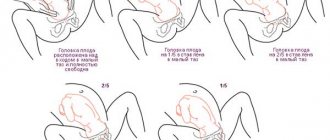Before pregnancy, most girls have little idea of what it’s like to bear and give birth to a baby. That is, they, of course, can imagine themselves with a nice round tummy, but they have a very little idea about many physiological aspects. For example, what is a mucus plug during pregnancy and what is it needed for, and most importantly, why is everyone so worried about when it goes away.
Of course, this question begins to worry all future mothers towards the end of pregnancy; every now and then doctors hear numerous questions: “I’m 38 weeks pregnant, the plug has come out, what should I do?” or “What will happen if I don’t notice when the plug comes out?” Moreover, having heard a lot of different stories, women begin to worry about what they should do if the plug comes out and labor does not begin... Let's talk about everything in order.
How and when does the plug come out?
If you are 38 weeks pregnant and the plug has come out, then there is no need to panic. But many have no idea how its release occurs and when it can happen. As the moment of birth of the baby approaches, the uterus, in preparation for childbirth, begins to contract, as if training (this is called training contractions).
In addition, under the influence of certain hormones, the viscosity of the mucous clot begins to decrease and it becomes more liquid. Among other things, the cervix is also preparing for childbirth; it opens a little and smoothes out. All these events together lead to the moment when the traffic jam comes out. It is impossible to determine the exact time of such an event, since each pregnancy is unique, and its course is purely individual.
If for some expectant mothers labor begins literally a few hours after the release of mucus, then for others labor begins only 2-3 weeks after this phenomenon. And for some, the plug comes off only during childbirth.
In addition, mucus can come out gradually and in tiny portions, which makes this process almost unnoticeable for a pregnant woman (so many say that they did not experience this at all). One way or another, the mucus plug will come out in any case, since it has fulfilled its function and is no longer needed by the mother and fetus.
How does it come out during the first birth?
During the first and repeated births, the plug comes out differently. In primigravidas, the cervical canal is narrow, the walls are strong, and the plug sits there firmly. And it does not come away as a single whole, but more often in parts or with blood . Therefore, the plug may not be noticed, because at the end of pregnancy, heavy discharge is not uncommon.
The plug may come out little by little over several days, just in the form of light beige discharge.
The color of the cork can be:
- transparent,
- pinkish,
- light brown,
- even slightly greenish.
Sometimes the plug may come out entirely. For first-time mothers, in 90% of cases, when the whole plug comes out, streaks of blood . When going to the toilet, it feels like something has fallen out. Or parts of the cork may be visible on the laundry. In this case, the woman does not experience pain, the maximum is light stretching in the lower abdomen, as before menstruation.
The plug came off at 40 weeks when I gave birth
October 8, 2014 | views: 46,885
40 weeks of pregnancy. If childbirth has not yet happened, then there is a fifty percent chance that it will happen soon. Although in fact, no matter how offensive it may sound, doctors do not know how to predict the expected date of birth.
As a hydrometeorological center, they hit the sky with their finger in 96% of cases. Therefore, even if it seems to you that you are desperately post-term pregnancy, there is no reason for even the slightest concern.
Take a closer look: at 40 weeks of pregnancy, the harbingers of labor sometimes manifest themselves very actively, maybe there are only a few hours left to wait?
40 weeks of pregnancy - the plug comes out
If only at 40 weeks of pregnancy the plug came out. This happens, it’s normal, it means that the body is just slowly but surely preparing for childbirth.
This does not mean at all that you should just sit with your hands clasped around your bag, nothing like that - mind your own business, but don’t go outside without an exchange card. You never know, kind people will call an ambulance if you start having contractions.
and explain later so that you are not sent to the ward of the infected.
Pregnancy 40 weeks, harbingers of labor - drooping belly
If your stomach drops. this means that the child takes the starting position and is waiting in the wings, he doesn’t have much time left to stay in his mother’s belly, so all that remains is to wait and believe that everything will work out.
40 weeks pregnant - the belly turns to stone
The feeling that at the 40th week of pregnancy the stomach becomes hard, it pulls, pain radiates to the lower back and pelvis, is also a direct sign that labor will begin soon. The bones diverge a little to allow the baby to pass through, the muscles hold the huge weight of the uterus and baby, so such painful sensations are normal and signal that everything is in order, the body is just getting ready.
Pregnancy 40 weeks, warning signs of labor - nausea and diarrhea
Also, in the fortieth week of pregnancy, you can often observe such precursors of labor as slight nausea, diarrhea and lack of appetite.
Sex at 40 weeks pregnant
By the way, sex at 40 weeks of pregnancy is not only not contraindicated, but is even quite prescribed as a means of natural stimulation of labor.
prostaglandins hormones contained in sperm, which help the uterus to activate contractile activity.
Therefore, if the husband has nothing against it, you can enjoy intimacy for your own pleasure - after giving birth, such an opportunity will not exist for a long time.
40 weeks of pregnancy - discharge
Discharge at the 40th week of pregnancy plays a special role in self-diagnosis; by its nature, one can determine whether there is any pathology. Whitish, odorless or mucous discharge is normal; drainage and normal leucorrhoea are now indicators of the absolute norm.
And, of course, it is worth keeping an eye on the discharge - often the amniotic fluid does not flow out immediately and completely, but begins to leak, and can be felt in wet underwear.
If you suspect that it is water, just lie down on a clean, dry sheet, relax and lie there for about fifteen minutes. If there is a leak, you may find a wet spot on the bed.
If it is colorless, you can safely get ready, but if it has a yellow or green tint, then this indicates that the fetus is experiencing a lack of oxygen, and you should immediately go to the hospital.
40 weeks pregnant - brown discharge
If you see even the slightest spotting, this indicates placental abruption. and under no circumstances should you hesitate to make this diagnosis; you should immediately call an ambulance.
And, of course, you should also make a call if the amniotic fluid has broken - all at once or it comes in “portions”, in any case, labor has already begun, and there is nothing more to wait for, you have to go. Very soon you will see your baby!
What does a blood plug mean?
Blood streaks in the mucus plug or parts of it are normal. But when the plug comes off with blood clots, or as a piece of bloody mucus, the pregnant woman should be wary.
Scarlet blood may be a sign of placental abruption . It is urgent, without waiting a minute, to call an ambulance and go to the maternity hospital. Placental abruption causes blood in the amniotic fluid. In the maternity hospital they will conduct an examination and if there is indeed a detachment, the woman in labor will have an emergency caesarean section.
Dark brown blood is most often not dangerous, it could be ruptures of the blood vessels on the cervix, this color of the blood indicates that it is old and superficial. But if after the plug comes out the bleeding does not stop, even if it is brown, you definitely need to go to the maternity hospital. Bleeding at any stage of pregnancy, of any color, is not the norm.
What is a mucus plug?
In a woman’s daily life, mucus is released freely, without lingering in the cervix. When pregnancy occurs, a sharp change in hormonal levels occurs. During all nine months, the female body undergoes changes that lead to the emergence of new functions.
Under the influence of hormones, mucus becomes thick, jelly-like, and tightly closes the lumen of the cervix, turning into a kind of plug.
Thus, mucus plays a protective role, creating a kind of tightness, preventing infection from entering through the cervical canal.
This is where its name came from - “cork”. Externally, it is ordinary mucus, only with a denser consistency.
A pregnant woman's mucus composition also changes.
It contains a large amount of prostaglandins, immunoglobulins, as well as enzymes - mucin, lysozyme, etc.
Thanks to their bactericidal properties, they prevent infection from penetrating into the cervix and then into the uterine cavity. This enhances protective functions. Due to the increased production of estrogens in the last months of pregnancy, the concentration of which increases sharply before childbirth, softening (liquefaction) of the mucus occurs, which forms a plug.
Prevention of premature release of the mucus plug
In order to prevent premature loss of the mucus plug and the onset of premature labor, it is necessary to follow simple rules of prevention, which consist of the following:
- avoid intense physical activity, do not overwork, lead a measured lifestyle;
- avoid psycho-emotional stress and stressful situations, so as not to provoke a spasm or sudden relaxation of the smooth muscles responsible for the tone of the uterus;
- observe the rules of personal hygiene, take a warm shower every morning and evening, change your underwear;
- contact a gynecologist in a timely manner if the first signs of acute or chronic infection of the internal genital organs appear (an imbalance of beneficial and pathogenic microflora can lead to destruction of the structure of the mucous plug, making it more liquid and causing premature loss with the risk of infection of the amniotic sac);
- do not have vaginal sex in late pregnancy, or do not allow deep penetration, and also be sure to use barrier contraception;
- exclude unauthorized use of medications (especially those that have antispasmodic properties and also contain natural and synthetic hormones);
- do not swim in open reservoirs and pools with cold water, as a sharp temperature change can provoke a reflex contraction of the muscle fibers of the vagina and cervix, which will lead to premature loss of the mucous plug;
- do not lift objects or things whose weight exceeds 3 kg.
When the plug comes out, how long does it take for labor to begin?
January 10, 2014
Pregnant women are looking forward to their babies, so they study the harbingers of labor in advance. These include: prolapse of the abdomen, contractions, passage of the plug and water, frequent urge to go to the toilet. Pregnant women are most concerned about the release of mucus, so we will consider 3 points: 1) what a plug is; 2) how it comes out; 3) if the plug comes out, how long does it take for labor to begin.
What is a cork?
Many pregnant women say that they did not have a plug, but this is not entirely true. A plug is a lump of mucus that thickens under the action of the cervix and closes the entrance to the uterus. Since this thick mucus performs a protective occluding function, it is nicknamed cork. Thanks to this clot, no infection can reach the child.
Typically, mucus is clear, beige, yellowish, or reddish in color. The plug may come out as a whole lump or come out in stages as a viscous liquid. If the color of the mucus is similar to the menstrual flow of the last few days, then do not panic, since the reddish tint is formed due to the bursting of small capillaries. If severe bleeding occurs, it is better to consult an obstetrician.
How does the plug come out?
Every pregnant woman has a protective clot, but the plug comes out differently for everyone. How long after labor begins after her birth is also individual. For some pregnant women, the plug comes out with a lingering, unpleasant, painful sensation, while for others it can come out painlessly while taking a shower, in the toilet, at the gynecologist’s office, or before the birth itself.
As soon as childbirth approaches, a new hormone appears in the female body, which softens the birth canal. In connection with this process, the plug flies out, and the cervix begins to open and prepare for the birth of the child. This process can take several weeks, days or hours, depending on the woman’s physical fitness, the number of births she has had and the baby’s readiness for birth.
And one moment. Most pregnant women on forums ask the question: The plug has come off, how can I speed up labor? , believing that a child will appear immediately after the mucus secretion. Be prudent, if the plug has come off and the cervix has not opened, then stimulation of labor will cause the water to break, as a result of which the baby will suffer, and the mother’s life may be in danger.
If the plug has already come out, how long does it take for labor to begin?
A clot of mucus may come out a month, 2 weeks, several days or hours before delivery. This is an individual process. Some pregnant women can go a month without a plug, while others, after the mucus has drained, give birth to a baby 6 hours later. Therefore, as soon as you feel that some discharge has come out of the vagina, go to your gynecologist.
But don't panic if the plug comes off right away. Look at other factors:
- what color is the discharge?
- whether the stomach has dropped;
- are there any contractions?
- whether the urge to go to the toilet has become more frequent.
If a pregnant woman has a drooping stomach, systematic pain in the lower abdomen, often has a strong pull to go to the toilet, the plug comes off, how long will it take to give birth in this case? The first labor may begin within a day, and repeated labor may begin within a few hours. In any case, you need to immediately call an ambulance. If the situation is not critical, then you can go for a consultation with a gynecologist as usual.
Please note that removing the plug requires special hygiene, as the child is susceptible to germs. This is especially true for the intimate life of spouses and swimming in open reservoirs and pools.
In any case, first consult with your doctor about how to protect your baby from viruses when the plug comes out. How long does it take for labor to begin after mucus is released - this will be a secondary question.
What to do?
If the plug comes off:
- Before 37 weeks of pregnancy.
It is worth informing your gynecologist. This is not necessarily something dangerous, but it is necessary to exclude premature birth, and to do this, conduct a series of studies.
- At 38 weeks and later.
This is normal and should not be reported to your doctor immediately. But mention this at your next visit to the antenatal clinic.
Contact your doctor immediately if you experience bright red bleeding after the plug comes out; this may be a sign of placenta previa or placental abruption.
What to do if the plug comes off at 35 weeks
The 35th week of pregnancy is, in fact, the last stage that completes the maturation of the fetus. The child is already quite developed, the weight is relatively large, the lungs are partially formed. A woman who carried her child to 35 weeks of pregnancy is considered to have honestly fulfilled her duty. All that remains is to wait for the birth itself.
The height of the mother's uterus from the navel is 15 cm. The fundus of the uterus by this time rises to the highest point during the entire pregnancy. At this stage, the stomach puts pressure on the chest, preventing you from breathing and eating properly. Therefore, it is best for mom to eat in small portions and intermittently. By this time, the woman’s weight gain is up to 13 kilograms. Difficulties with sleep appear. After all, the frequent urge to urinate (about every 40 minutes) does not allow you to sleep peacefully. Not to mention back pain. In the fight against insomnia, drinking less water, as well as doing some light but meaningful activity during the day, will help. At this time, the mother, as before, needs to rest more, gain strength, not be nervous and spend more time in the fresh air. Week 35 is the time when you need to stock up on nursing bras and start attending maternity courses.
During this period, all the organs and systems of the child already exist, but they also continue to develop. Very soon the fruit will begin to fall. The walls of the uterus constrain the child, because he is already very big. The weight of the baby at 35 weeks of pregnancy is just over 2.5 kilograms. Due to the tightness, the child no longer moves so often and not so energetically; now he seems to be rolling around. From this week the child will gain 220 grams every week. The improvement of internal organs will continue. The baby's full height is up to 46-50 centimeters.
Childbirth at 35 weeks is possible, although not the norm
The most important thing at this time is not to miss the moment of the onset of labor. Water leakage is one of the many symptoms of the onset
If a woman notices a simple leakage of amniotic fluid, even if nothing bothers or hurts, she should immediately contact the maternity hospital.
Now it’s worth figuring out how long it takes for the plug to come off. A mucus plug is mucus produced by the cervix that “clogs” the uterus, protecting the baby from various types of infections. There are no specific dates for this process, but, as a rule, it goes away at the end of pregnancy, starting from the 34th week. The plug looks like a dense lump of mucus streaked with gray-yellow blood. If the plug begins to come off, this does not mean that labor is about to begin. The plug may come off over time (up to several weeks). in a few hours. If the plug comes out when labor has already begun, this is not abnormal and does not affect the process in any way. The expectant mother should closely monitor her health; she should know for sure that the plug is very small in size, and blood is not released after it is removed. If you notice a large amount of blood or fluid, you should immediately contact an obstetrician-gynecologist. What to do if the plug comes off? This question plagues women who are not yet particularly familiar with the process of childbirth and will be giving birth for the first time. If the plug comes out at 35 weeks of pregnancy, this is, in principle, completely normal. After all, if premature birth occurs, the baby is already almost fully formed, and nothing threatens him. But there is a high probability that the woman will still complete her term even after the plug has come off. It happens when the plug comes off gradually, at which point it may not be noticed or confused with normal vaginal discharge.
In 2004, a girl weighing only 260 grams was born during a premature birth in Illinois. This child was slightly smaller than his twin sister, who was born weighing 600 grams. The girls were raised with the help of special equipment, and now they are absolutely no different from their peers.
The 35th week of pregnancy is the last stage in the baby’s development and growth. At this time, he can even be born, there is nothing dangerous in this, because the baby is already ready to see the world. But still, the best thing is when the baby is born on time. A mother must monitor her health, but also, of course, the health of her baby, so that nothing overshadows the joy of motherhood
An important activity for an expectant mother is education about the processes of pregnancy.
Expert commentary
Separation of the mucous plug from the vagina indicates the harbingers of labor. Moreover, it doesn’t matter in what time frame. begin by the same mechanism as physiological or delayed ones.
The mucus plug is formed from the secretion of the cervical glands
. This is a thick jelly-like mass that fills the entire cervical canal. The secretion of the cervical glands is constantly maintained by high levels of estrogens and gestagens, hormones responsible for the growth and maturation of the fetus.
Thus, the mucus plug is not an accumulation of thick fluid
, formed from the very beginning of pregnancy. The secretion of cervical cells occurs continuously, and the mucus plug always remains “fresh”.
It fills the inside of the cervix 4-5 centimeters long: completely, leaving no gaps between the walls of the canal. Mucus contains antibodies
– immune cells that neutralize pathogens.
Before labor begins, the balance of female hormones changes. There are significantly more estrogens than gestagens. That is, the process of fruit ripening is considered complete and is cancelled. Under the influence of estrogen, the mucous plug liquefies
followed by its separation.
In primiparous and multiparous women
The separation of the mucus plug proceeds in different ways.
The fact is that the cervix of the uterus in nulliparous pregnant women
has a smaller channel diameter, and its walls are quite dense, which hold the mucus so firmly that the mucus plug comes off either with blood or in parts.
At the same time, prenatal structural changes in the cervical canal occur, which are accompanied by the separation of epithelial cells. This is accompanied by minor bleeding. Therefore, nulliparous pregnant women
streaks of blood are noted in slight thick discharge.
In women who have given birth
The inner surface of the cervical canal is elastic.
The integumentary epithelium is loosened, and the intercellular spaces are able to stretch. Therefore, the mucus plug in women who have given birth
comes off instantly and bloodlessly.
Regardless of parity (number of births)
Separation of the mucus plug from the cervical canal in pregnant women occurs painlessly.
Exception
General statistical cases
include women with lesions of the cervical canal
. Scars on the inner lining of the cervix are formed due to its forced expansion during abortion or inflammatory lesions of cervical cells due to Trichomonas infection.
is much less common in women who have given birth again
when the mucous plug passes,
it is associated with the presence of the cervix.
Normally, the mucous plug comes out 3-5 days before the onset of labor.
. The amount of thick liquid is insignificant. No more than during ovulation. Because ovulatory mucus fills the cervical canal, the size of which remains unchanged during pregnancy.
Separation of the mucus plug indicates
hormonal changes in the body of a pregnant woman, which ensure labor, canceling the process of bearing a child. This process is physiological and does not require medical intervention.
At the same time, with discharge from the genital tract that has not been examined under a microscope, it is impossible to distinguish where it came from: from the cervical canal or from the uterus?
Amniotic fluid sometimes breaks before labor begins.
Separation of the mucus plug does not mean that
the protection of the fetus from vaginal microflora is impaired, since the second and more important barrier is the dense membrane of the amniotic sac.
But with a tear in the amniotic membrane
(which also occurs absolutely painlessly), the risk of infection of the fetus becomes irreversible and steadily increases. The water-free period is counted in hours and minutes.
It is impossible to determine what kind of vaginal discharge appears at home. Therefore, when they appear, you should note the exact time and call an ambulance. Whether it is a mucous plug or amniotic fluid - only a doctor can determine.
Every woman during pregnancy waits with impatience and trepidation for the onset of childbirth. Someone is rushing this moment, and someone wants to delay it for a little while longer, but it is impossible to predict the development of labor with 100% accuracy - in any case, it will begin suddenly. Many expectant mothers have heard that the plug comes off before childbirth, but only a few of them have a correct idea of how this happens.
So, how many days before birth does the plug come out? How does she look? Does this plug come off before childbirth for everyone? And when should you go to the maternity hospital if everything happens? All these questions create panic in a woman’s head, and the expectant mother does not need unnecessary worries and worries on the eve of the birth of the baby. Therefore, in order not to worry, you need to stock up on the necessary knowledge in a timely manner in order to know how to behave and what to do if labor begins.
With the onset of pregnancy, a specific transparent clot forms in the cervical canal - this is the mucus plug. Its formation is associated with hormonal changes in the body. Visually, the plug resembles a dense lump of light mucus. The dense structure of the cork performs a protective function, reliably protecting the fetus from the possible negative influence of the external environment. The plug reliably closes the cervical canal, thanks to which the unborn child is protected from infections, pathogenic bacteria and other pathogenic factors.
It turns out that when the plug comes out before childbirth, a path opens for the penetration of infectious pathogens, etc. into the uterine cavity. That is why doctors strongly recommend that after the plug comes out before childbirth, avoid swimming in the bathroom, in the pool, in open bodies of water, maintain careful intimate hygiene, and in general be more careful.
The plug has come off. When to expect childbirth
With a dilatation of 3 cm, my friend walked for 4 days (she started having contractions, but then stopped on their own). It might have taken longer, but she was given stimulation.
On the pages of the Mail.Ru Children project, comments that violate the legislation of the Russian Federation, as well as propaganda and anti-scientific statements, advertising, and insults to the authors of publications, other discussion participants and moderators are not allowed. All messages with hyperlinks are also deleted.
The accounts of users who systematically violate the rules will be blocked, and all messages left will be deleted.
You can contact the project editors using the feedback form.
Does the plug always come off?
Some women claim that they did not see any plug before giving birth, so it does not come out for everyone. This statement is erroneous - the plug must come out before childbirth for every expectant mother.
If the mucus plug did not exist, carrying a child to term would not be an impossible task, since the fetal membranes would be constantly in contact with pathogenic microflora.
Most likely, many women do not notice its release, since this process can really go unnoticed - while taking a bath, shower, when visiting the toilet, or along with fetal fluid. Sometimes the plug is born with the baby.
There is no pathology in this. Therefore, you should not constantly think about the question of whether the mucus plug always comes off before childbirth. Everything will happen at the right moment, when the time comes.
What does a traffic jam look like during pregnancy?
Expectant mothers repeatedly wonder what a plug should look like during pregnancy.
Depending on the characteristics of the mother’s body and the factors influencing it, she may look different during rejection.
Shape, size and appearance
In most cases, the consistency of the cork resembles jelly - a gel-like viscous clot. The pregnancy plug in the photo can be compared to a transparent jellyfish. Sometimes it can be difficult to distinguish the passage of a plug from normal discharge because its consistency does not necessarily have to be thick.
More often the clot comes out whole, in a mass, about a couple of tablespoons in volume. The size of the lump is approximately one and a half centimeters in diameter.
It is not a cause for concern when the plug comes off during pregnancy in parts in the form of small lumps, or simply spotting discharge, which in appearance resembles the approach of menstruation.
Color
The color of the plug during pregnancy can vary from transparent to whitish, beige, pinkish, yellowish, gray-brown - these are normal shades of mucous discharge.
Before the onset of labor, the uterus puts pressure on the cervix, so in the process of rejection of the plug, the capillaries burst. This is a natural process; a small amount of blood gives the mucous clot a soft pink or yellowish tint. For this reason, the cork may contain bloody streaks.
A small amount of blood discharge is acceptable, but a large volume of scarlet blood may indicate placental abruption or other disturbances in the natural process. A lot of bleeding is a reason to immediately go to the hospital.
Green color of mucus means that the baby does not have enough oxygen. A sign of oxygen starvation is an immediate reason for hospitalization.
How to distinguish a plug from a water leak?
Sometimes the discharge may not be of a very thick consistency; it is difficult to distinguish it from water leakage. However, the process of leakage is different from how a plug comes out during pregnancy.
Amniotic fluid often comes out in one large stream, but sometimes there are leaks. If the plug comes out several times in portions of up to 2 tablespoons, then leaking water can be observed continuously.
If when coughing, sneezing, lower back tension and any sudden movements there is a release of watery liquid, this is water. The cork may be liquid, but not watery; its consistency is slimy.
Appearance and purpose of the mucus plug
The mucus plug is a kind of barrier between the outside world and the fetus developing in the womb. It is formed at the beginning of pregnancy from mucus, intensively secreted by the body under the influence of hormones. Gradually its thickening is observed. By the end of pregnancy, the plug is a dense jelly-like substance.
After 38 weeks, the expectant mother’s body stops producing progesterone. As a result, the cervix shortens and softens, and the mucous plug gradually moves away. This process takes from several hours to two weeks. Sometimes the release of the mucus plug occurs immediately before childbirth.
Each case is a variant of the norm. The separation of the plug does not mean that the woman will give birth at that moment. This is a signal indicating the body's readiness for delivery.











